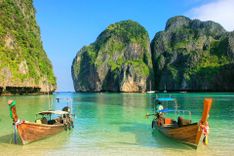After the tsunami
The Boxing Day tsunami hit Thailand’s Andaman coast just after 9.30am on December 26 2004. The first place to suffer significant damage was Phuket, and the next two hours saw village after resort get battered or decimated by the towering waves thundering in from the Sumatra fault line, 1000km away. The entire coastline from Ranong to Satun was affected, but not all of it with the same intensity: the worst-hit province was Phang Nga, where 4200 people were recorded dead or missing, many of them in the resort of Khao Lak; over 2000 suffered a similar fate on Ko Phi Phi; and more than 900 died on the beaches of Phuket, especially on Patong and Kamala. There were 8212 fatalities in all, a third of them holidaymakers. Another 6000 people were made homeless and some 150,000 lost their jobs, mostly in the tourism and fishing industries. By the end of that day, nearly a quarter of a million people in a dozen countries around the Indian Ocean had lost their lives in the worst natural disaster in recorded history.
Many homes, shops and hotels were quite swiftly rebuilt, but the emotional and social legacy of the tsunami endures and most residents along the Andaman coast have a story of terror and bereavement to tell. It’s no surprise that many survivors are now afraid of the sea: fearing ghosts, some longtail boatmen won’t motor solo past where villages once stood, and hundreds of hotel staff have since sought new jobs in the northern city of Chiang Mai, as far from the sea as they could go.
Immediately after the tsunami, many were surprised when then prime minister Thaksin Shinawatra declined offers of aid from foreign governments. But help poured in instead from the Thai government and from royal foundations and local and foreign NGOs and individuals. Of the many projects established to help support and rebuild affected communities, the majority have now completed their task; others have evolved into longer-term NGO ventures, including an English-teaching programme in Khao Lak, and the community-based tourism company Andaman Discoveries in Khuraburi.
Generosity and altruism were not the only responses to the disaster, however. Almost every tsunami-affected community talks of dishonourable practice and corruption, experiences which have caused bitterness and rifts. Many allegations concern donated money and goods being held back by the local leaders charged with distributing them, and in some cases big business interests muscled in on land deemed “ownerless” because the paperwork had been lost to the waves. Most small businesses had no insurance, and government compensation was inconsistently awarded and invariably lacking. In a country where most family enterprises scrape by season to season, it’s sobering to contemplate the number of tsunami victims who simply picked up and started over.
Determined not to be caught unawares again, in the unlikely event of Thailand being struck by a second tsunami, the government has created a tsunami early-warning system that relays public announcements from towers all the way down the Andaman coast. They have also mapped out evacuation routes, flagged by innumerable “Tsunami Hazard Zone” signs in all the big resorts. For their part, Phuket authorities have remodelled stretches of Ao Patong’s beachfront as a building-free zone, creating a park that doubles as a tsunami memorial. Krabi officials now require all new buildings to be constructed at least 30m inland from a high-tide boundary, and they even forbid the use of sunloungers below that point. In Khao Lak, a beached police boat has become an eloquent memorial: it rests where it was hurtled by the wave, 2km inland, on the other side of the highway.
Diving and snorkelling around Khao Lak
Khao Lak is the closest and most convenient departure point for diving and snorkelling trips to the awesome national park islands of Ko Similan, which can be reached in three to four hours on a live-aboard or other large boat or in two hours in a much less comfortable speedboat. The islands are currently only open from approximately November to April and all divers have to pay a one-off national park fee of B400 plus a B200-a-day diving fee, usually on top of dive-trip prices. Local Khao Lak dives are generally possible year-round, especially the highly rated wreck of a tin-mining boat near Bang Sak, which is especially rich in marine life such as ghost pipefish, moray eels, scorpion fish, nudibranchs and yellow-tail barracuda. All Khao Lak dive shops also teach PADI dive courses, with the last two days of the Openwater course often done on location in the Similans.
IQ Dive
Swiss–Thai-run PADI Five-Star Centre that specializes in one-day dive trips to the Similans, on a big dive boat (B4700 plus equipment; B2800 for snorkellers). Their Openwater courses cost B17,000 with two days spent diving the Similans.
Sea Dragon Dive Center
Highly recommended PADI Five-Star Instructor Development Centre which has three live-aboard boats – including budget and deluxe options – running frequent three-day trips to the Similans and Ko Bon (from B11,900 including equipment), and four-day trips to the Similans, Surin islands, Ko Bon, Ko Tachai and Richelieu Rock (from B17,900). Snorkellers get about one-third off. Also offers local wreck and other dives (starting from B1000, not including equipment, for a two-tank dive) and PADI dive courses: the four-day Openwater is B9800, or B15,900 (plus B1200 national park fees) with two day-trips diving the Similans.
Similan Tour
Highly recommended three-day live-aboard snorkelling trips to the Similans (B8200). Current departures are twice weekly on Tuesdays and Fridays, from roughly the end of October to May.
Khao Lak day-trips and other activities
Aside from diving and snorkelling trips, there are several other attractions within day-tripping distance of Khao Lak, including a number of local waterfalls. Of these, Sai Rung (Rainbow Falls), about 16km north of Nang Thong in Bang Sak, is the most satisfying. Others include Tong Pling, across from the Merlin resort in Khao Lak; Nam Tok Lumphi, about 20km south of Khao Lak; and Chong Fah Falls, located less than 5km east of Bang Niang, but subject to a B100 entry fee because it’s part of Khao Lak–Lam Ru National Park. The national park’s headquarters is on the headland between Nang Thong and Khao Lak beaches, and about 1km south of it, you can easily walk down to a quiet, pretty sandy cove – look for a sign saying “small sandy beach” on the west side of the main road, opposite a layby.
Everyday 2 Restaurant
Morning Thai cooking courses, including pick-ups.
The Green Biking Club
Runs interesting guided mountain-bike trips around rural and coastal Khao Lak.
Khao Lak Land Discovery
One of the best and most reputable, though not the cheapest, local tour operators, whose day-trips include elephant-riding, kayaking around Ao Phang Nga and trekking, canoeing and elephant-riding in Khao Sok National Park.
The Yoga Studio
High-season yoga classes – see the website for the schedule.
Thinking of travelling to Khao Lak? Start planning by learning about how to get to Thailand.





